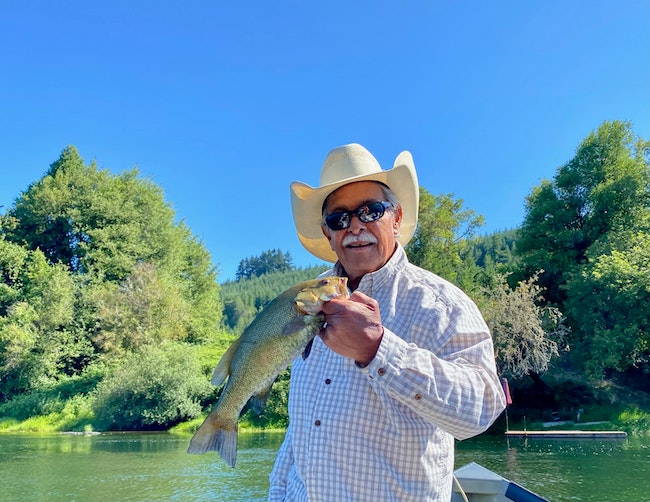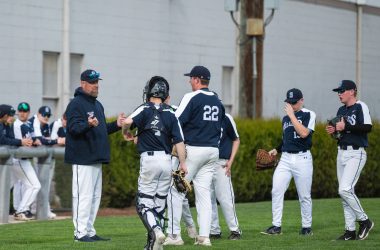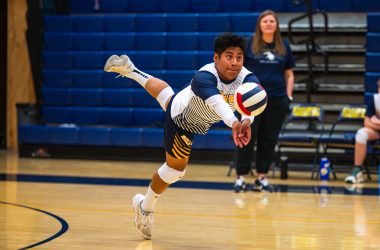 FRANK ARMENDARIZ / FOR THE CHRONICLE
FRANK ARMENDARIZ / FOR THE CHRONICLE
Armendariz with an Umpqua smallmouth bass caught while fly fishing. Armendariz landed a couple of dozen fish that were much larger. Pictured is an average-sized fish from a stretch of the river down stream from Tyee.
From the confluence of the North and South Umpqua rivers, the Main Umpqua River meanders westward for about 110 miles before reaching the Pacific Ocean at Winchester Bay. Of those 110 miles, 87 are river miles that extend down river from the confluence to the head of tidewater. Through that entire length, anglers will find strong populations of smallmouth bass.
On the South Fork, bass are predating on salmon and steelhead smolts, adding to the numerous obstacles involved in improving anadromous fish numbers on the South Umpqua. The ODFW sanctioned what are essentially catch and kill bass tournaments to remove some of the larger fish.
A recent tournament captured hundreds smallmouth, mostly by fly fishing. On the North Fork, a dam and fish ladder have kept the bass at bay. Although summer steelhead have been in decline, the North Fork still spawns one of the most abundant runs of some of the largest winter steelhead found in Oregon waters.
From the Southern Willamette Valley, the river is most easily accessed from Interstate 5:
- Exit Sutherlin at State Highway 138 West to Fork McKay Road
- Right at Tyee Road
- Tyee parallels the river from the hamlet of the Umquea to Elkton.
If you are traveling north on the interstate:
- Exit West on Garden Valley Road in Roseburg
- Past River Forks to State Highway 138
- River Parks sits at the confluence of the North and the South forks, markinh the upper most boat landing on the Main Umpqua River.
As you float down river or travel west on the highway, Umpqua, James Woods, Osprey Yellow Creek and Tyee landings come up – some of the best four-season landings along the entire length of the river. The upper landings are also conveniently spaced. Each run has its highlights but all cover plenty of good bass holding water – enough to make for an eventful day of smallmouth angling and the likelihood of catching over 50 smallmouth bass. The bank access is also fair along the upper river, the best being right around the boat landings.
The river is warm in the summer, relatively gentle in the upper parts of the Main Umpqua, with several class one and the occasional “class two” rapid, making it ideal for small pontoon boats, kayaks, rafts, canoes and drift boats. The water in the upper river can get a little “skinny” in a few places but I’ve always been able to safely navigate my drift boat over the shallows.
The character of the river could best be described as “pool and drop.” With a gradient of only a couple of feet per mile, the pools can be hundreds of yards long, causing the current to slow to what feels more like a lake.
Down stream from Tyee, the Umpqua is nearly inaccessible. Because of the lack of access, the segment has become pretty popular among river campers. Most people plan for at least three river days on a float from Tyee to Elkton.
Be aware of significant rapids that are capable of upsetting any style of boat. Quarter, Brads Creek, Ferry Point and others can be shallow, narrow and surprisingly step because they often represent the entire decent of a half-mile or more of river bed.
Because of the accessability difficulties, the fish are impressive. On a recent trip, we were granted access to a private landing about 15 miles down stream from Tyee. The action was just incredible all day long. Most memorable were the 12 18-to-20-inch fish our party of four each caught every day; a few spotted were even bigger.
When on the Umpqua River, I always fly fish for the smallmouth and find it to be every bit as effective (in most conditions even more so) as any other rod, reel and lure combination. I also enjoy the basic nature of fly fishing with a single-action reel – a willowy rod and using simple flies that we tie at home.
Often, when you say you were fly fishing, people think of a guy standing waste-deep in a river making “A River Runs Through It” 50-foot casts. You can do on the Umpqua; however, you are likely not going to catch very many bass fishing like that, as most of the biggest bass in the Umpqua are found in the deep slots, under ledges and around other structure in the deeper runs. The fish are not line or boat shy, allowing you to get right over the top of them where a vertical presentation puts your fly right in their face. It’s an enticement they can seldom resist.
Working with no more than 20 feet of floating fly line behind a 10-foot leader, I flip my weighted fly upstream and allow it to sink, reaching the greatest depths just upstream from the bow of boat. The fly swings past the boat – essentially a short line nymph technique – to fish you can often see.
“Sight fishing” is the key to a day of slamming one trophy bass after another. When approaching the fish, a drift boat or a fly fishing-specific raft and frame package is advantagous to sight fishing. Standing gives you a better view and allows you to target the bigger fish. Sitting at water level just won’t give you that perspective.
Smallmouth bass fishing on the Main Umpqua River is good all the way into mid-October.
Email: [email protected]
Radio: KDUN, 1030AM







